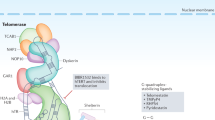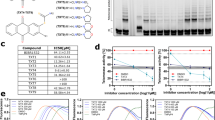Abstract
Telomerase is a promising target for human cancer gene therapy. Its inhibition allows telomere shortening to occur in cancer cells, which in turn is thought to trigger delayed senescence and/or apoptosis. We tested whether telomerase inhibition might have additional, immediate effects on tumor cell growth. Ovarian cancer cell lines with widely differing telomere lengths were efficiently transduced with an adenovirus expressing a ribozyme directed against the T motif of the catalytic subunit of human telomerase, hTERT. Three days after transduction, telomerase activity was significantly reduced and massive cell loss was induced in mass cultures from all four ovarian cancer cell lines tested, whereas transduction of telomerase-negative human fibroblasts did not attenuate their growth. The kinetics of induction of cell death in cancer cells was not significantly dependent on telomere length, and telomeres did not shorten measurably before the onset of apoptosis. The data suggest the existence of a “fast-track” mechanism by which diminution of telomerase can interfere with cancer cell growth and induce cell death, presumably by apoptosis. This phenomenon might be a consequence of the telomere capping function provided by telomerase in tumor cells. Uncapping of telomeres by ribozyme-mediated inhibition of telomerase bears therapeutic potential for ovarian cancer. Cancer Gene Therapy (2001) 8, 827–834
This is a preview of subscription content, access via your institution
Access options
Subscribe to this journal
Receive 12 print issues and online access
$259.00 per year
only $21.58 per issue
Buy this article
- Purchase on Springer Link
- Instant access to full article PDF
Prices may be subject to local taxes which are calculated during checkout
Similar content being viewed by others
References
Verma IM, Somia N . Gene therapy — promises, problems and prospects Nature 1997 389: 239–242
Vile R . Cancer gene therapy — new approaches to tumour cell killing J Gene Med 2000 2/2: 141–143
Runnebaum IB, Buller R, Peagram M, et al . Phase I/II gene therapy in recurrent ovarian cancer with intraperitoneal recombinant adenoviral human p53 J Cancer Res Clin Oncol 2000 126: (Suppl) R43
Olovnikov AM . A theory of marginotomy: the incomplete copying of template margin in enzymic synthesis of polynucleotides and biological significance of the phenomenon J Theor Biol 1973 41: 181–190
Harley CB, Futcher AB, Greider CW . Telomeres shorten during aging of human fibroblasts Nature 1990 345: 458–460
Petersen S, Saretzki G, von Zglinicki T . Preferential accumulation of single-stranded regions in telomeres of human fibroblasts Exp Cell Res 1998 239: 152–160
von Zglinicki T, Pilger R, Sitte N . Accumulation of single-strand breaks is the major cause of telomere shortening in human fibroblasts Free Radical Biol Med 2000 28: 64–74
von Zglinicki T, Serra V, Lorenz M, et al . Short telomeres in patients with vascular dementia: an indicator of low antioxidative capacity and a possible risk factor? Lab Invest 2000 80: 1739–1747
Bodnar AG, Oulette M, Frolkis M, et al . Extension of life-span by introduction of telomerase into normal human cells Science 1998 279: 349–352
Karlseder J, Broccoli D, Dai Y, et al . p53- and ATM-dependent apoptosis induced by telomeres lacking TRF2 Science 1999 283: 1321–1325
Hahn WC, Counter CM, Lundberg AS, et al . Creation of human tumour cells with defined genetic elements Nature 1999 400: 464–468
Feng J, Fun W, Wang SS, et al . The RNA component of human telomerase Science 1995 269: 1236–1241
Kondo Y, Kondo S, Li G, et al . Targeted therapy of human malignant glioma in a mouse model by 2–5A antisense directed against telomerase RNA Oncogene 1998 16: 3323–3330
Komata T, Kondo Y, Koga S, et al . Combination therapy of malignant glioma cells with 2–5A-antisense telomerase RNA and recombinant adenovirus p53 Gene Ther 2000 7: 2071–2079
Zhang X, Mar V, Zhou W, et al . Telomere shortening and apoptosis in telomerase-inhibited human tumor cells Genes Dev 1999 13: 2388–2399
Herbert BS, Pitts AE, Baker SI, et al . Inhibition of human telomerase in immortal human cells lead to progressive telomere shortening and cell death Proc Natl Acad Sci USA 1999 96: 14276–14281
Hahn WC, Steward SA, Brooks MW, et al . Inhibition of telomerase limits the growth of human cancer cells Nat Med 1999 5: 1164–1170
Folini M, Colella G, Villa R, et al . Inhibition of telomerase activity by a hammerhead ribozyme targeting the RNA component of telomerase in human melanoma cells J Invest Dermatol 2000 114: 259–267
Ludwig A, Saretzki G, Holm PS, et al . Ribozyme cleavage of telomerase mRNA sensitizes breast epithelial cells to inhibitors of topoisomerase Cancer Res 2001 61: 3053–3061
Blackburn E . Telomere states and cell fates Nature 2000 408: 53–56
Brüning A, Köhler T, Quist S, et al . Adenoviral transduction efficiency of ovarian cancer cells can be limited by loss of integrin beta 3 subunit expression and increased by reconstitution of integrin alpha v beta 3 Hum Gene Ther 2001 12: 391–399
Feng M, Cabrera G, Deshane J, et al . Neoplastic reversion accomplished by high efficiency adenoviral-mediated delivery of an anti-ras ribozyme Cancer Res 1995 55: 2024–2028
Sgonc R, Gruber J . Apoptosis detection: an overview Exp Gerontol 1998 33: 525–533
Griffith JD, Comeau L, Rosenfield, S, et al . Mammalian telomeres end in a large duplex loop Cell 1999 97: 503–514
Saretzki G, Sitte N, Merkel U, et al . Telomere shortening triggers a p53-dependent cell cycle arrest via accumulation of G-rich single stranded DNA fragments Oncogene 1999 18: 5148–5158
Acknowledgements
This work was supported by grants from the Deutsche Forschungsgemeinschaft (Ru476/3-1 granted to I.B.R., Zg2/4-3 granted to T.v.Z), the Berliner Krebshilfe (T.v.Z.), the Verum Foundation (T.v.Z) and by funds of the State of Baden-Württemberg (ZKFI, Freiburg, C-9, granted to I.B.R.). The authors thank B. Keys (Newcastle), L. Walz and I. Engels (Freiburg) for technical support.
Author information
Authors and Affiliations
Corresponding author
Rights and permissions
About this article
Cite this article
Saretzki, G., Ludwig, A., von Zglinicki, T. et al. Ribozyme-mediated telomerase inhibition induces immediate cell loss but not telomere shortening in ovarian cancer cells. Cancer Gene Ther 8, 827–834 (2001). https://doi.org/10.1038/sj.cgt.7700383
Received:
Published:
Issue Date:
DOI: https://doi.org/10.1038/sj.cgt.7700383
Keywords
This article is cited by
-
Telomerase reverse transcriptase promotes chemoresistance by suppressing cisplatin-dependent apoptosis in osteosarcoma cells
Scientific Reports (2017)
-
New prospects for targeting telomerase beyond the telomere
Nature Reviews Cancer (2016)
-
Complementary treatment of siTERT for improving the antitumor effect of TERT-specific I-131 therapy
Cancer Gene Therapy (2012)
-
Telomerase and cancer therapeutics
Nature Reviews Cancer (2008)
-
Mechanism of induction of apoptosis by siRNA targeting hTERT in HeLa cells
Chinese Journal of Cancer Research (2008)



